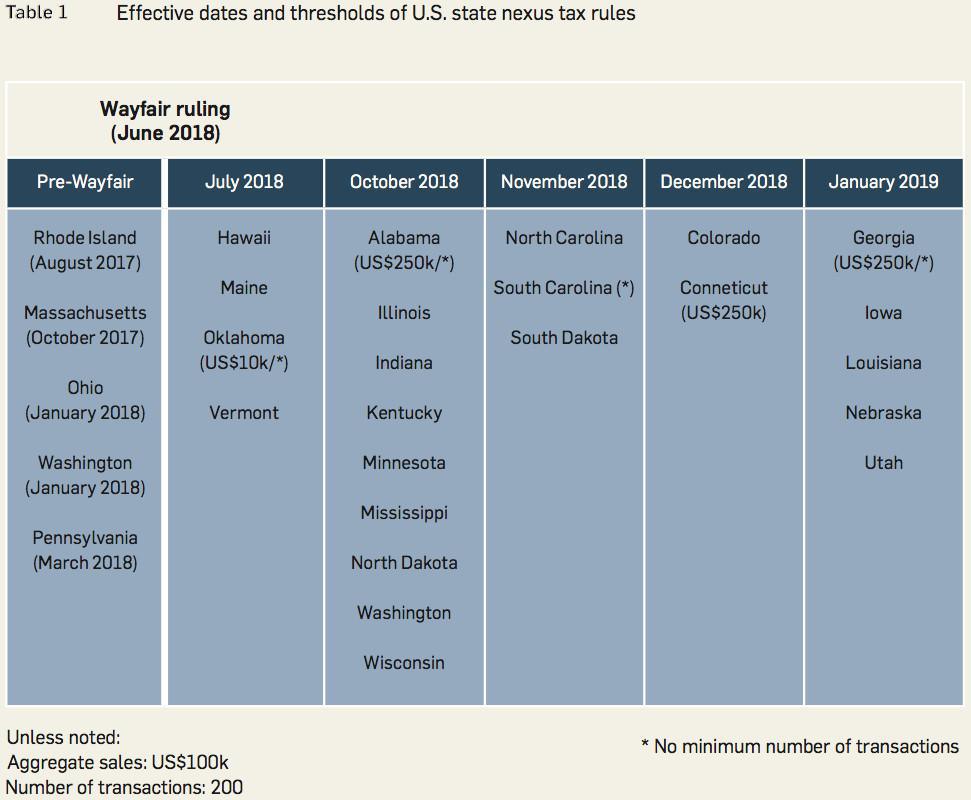In today’s increasingly digital economy, flows of goods and services can be seamlessly transacted through electronic means all over the world at any time of a day and night. Existing tax rules in most countries are not up to speed with this new economy, while the other countries are adopting their own set of rules from both direct tax and indirect tax perspectives to avoid loss of revenues. The Organization for Economic Cooperation and Development (OECD) published the BEPS Action 1 Report in 2015 and the Interim Report in 2018 to address the tax challenges arising from digitalization on cross-border trade in goods, services and intangibles, hoping to provide a more unified direction of work on digitalization. The OECD has called for international consensus on the way forward and plans to come up with a consensus-based solution by 2020. Nevertheless, some countries and the European Union (EU) have already begun to revamp their own tax regime to cater for the digital economy.
This article shares the latest developments of major economies in the world in the taxation of trade of tangible goods across the border through electronic means.
European Union – a new VAT regime
The European Commission (EC) adopted new rules on Value Added Tax (VAT) for e-commerce in December 2017, which aims at modernizing the current VAT regime for cross-border e-commerce players, reducing administrative burden for businesses arising from different VAT regimes among the member states of the EU, and regulating tax losses from VAT fraud. The basic principle is that VAT is charged in the country where the customer is a resident, regardless of whether the customer in the member state is a business entity (i.e. a B2B sale) or a private consumer (i.e. a B2C sale).
Under the current VAT treatment of sales of goods to private customers within the EU (i.e., distance sales), both EU and non-EU businesses are obliged to register for VAT purposes in each member state when their sales to that state exceed the given threshold. In order to make the EU VAT system more business friendly and hence encourage compliance, one focus of the new rules is to simplify the administrative procedures by the extension of the existing Mini One Stop Shop system to include distance sales of goods from January 2021. The extended “One Stop Shop system” will allow businesses to handle their VAT registration and payment across the EU through one single online portal hosted by the local tax authorities of the country of dispatch.
Another focus of the rules is to fight against e-commerce VAT fraud. The EC has proposed several measures to monitor VAT compliance and the source of data will be from key players in this economy who possess the online sellers’ data. Going forward, these online marketplaces (including platforms or portals that facilitate distance sales of goods within/imported into the EU) will be responsible for ensuring that VAT is collected on the distance sales of goods by non-EU companies traded on their platforms. As online marketplaces will be liable for paying any missing VAT to the tax authorities arising from the non- compliance by the sellers it is expected that they will help ensure sales are properly reported and taxed.
With over 90 percent of the online purchases made by European customers involving a payment intermediary, data held by these intermediaries would be useful for the EU tax authorities to monitor VAT compliance. Accordingly, it has been proposed that these payment service providers (such as credit card and direct debit providers) will have quarterly information-sharing obligations to share the relevant payment data with authorities and anti-fraud specialists. Although it will take at least some years for the EC to develop a central electronic storage system for payment information, such a measure will allow authorities to cross-check the data collected from online marketplaces and uncover the identities of those non-compliant online sellers.
Takeaways
Although the relevant regulations are yet to be finalized, Hong Kong companies engaging in cross-border e-commerce and selling to EU customers should start assessing their current and future VAT registration and compliance obligations in the EU based on their business models in light of the enhanced transparency of data going forward. We have also seen non-EU companies start to explore setting-up local entities in the EU to centralize the distribution and local e-commerce functions, as well as enhancing their VAT management and tax efficiency.
United States – A Supreme Court case determined that an internet furniture retailer is also a collection agent for sales and use tax
In December 2017, the Tax Cut and Jobs Act (the U.S. Tax Reform) was signed into law, the most significant overhaul of the U.S. federal tax code in more than 30 years. Yet changes in the U.S. tax systems have continued in this ever-changing world. Notably, and this time in the context of the U.S. state and local sales and use tax (S&UT), in June 2018, the U.S. Supreme Court in South Dakota vs. Wayfair overruled the Quill’s 26-year-old physical presence standard by a 5-to-4 majority.
Unlike VAT elsewhere, the U.S. state and local S&UT is imposed only on end customers, which is collected by the vendor and remitted to the relevant localities. Whether a vendor is obligated to collect and remit S&UT to a state depends on whether it has a business connection (referred to as a “nexus”) with that state. In Quill, the lack of physical presence in a state would exempt a vendor from having to collect and remit S&UT. Accordingly, vendors selling goods out-of-state through the internet or other distance sales (e.g. catalogue sales) would not be required to collect S&UT in the past and hence, the vendors would have a pricing advantage.
With the increasing trend of internet purchases, state tax authorities have been challenging the physical presence standard. For example, in 2016, South Dakota instituted an economic presence standard that required S&UT collection and remittance for any entity exceeding an annual sales threshold of US$100,000 or engaging in 200 or more separate transactions in the state, and many other states have similar statutes with the majority choosing the same thresholds.
The Supreme Court agreed to hear the case in January 2018, heard it in April, and issued its decision in June 2018, which overturned Quill, ruling that the physical presence rule was “unsound and incorrect” in the age of internet services. The Court found that a “substantial nexus” exists between out-of-state retailers and South Dakota by virtue of economic and virtual contacts by the state. The Wayfair decision has changed the landscape of S&UT collection for remote sellers and has far-reaching implications. Many states are taking a measured approach of reviewing the case to decide how their laws apply in view of the holdings in Wayfair and the enforcement date. Some of the bigger states, e.g., California and New York, are still pending how to go about the Supreme Court decision. Table 1 below summarizes states that have instituted the sales tax economic nexus thresholds.
.
Treaty protection is irrelevant to S&UT nexus as treaties are only applicable in the U.S. federal income tax context. Multinationals selling from a treaty jurisdiction, such as China, to a state and meeting that state’s statutory economic presence threshold are still required to collect and remit S&UT.
Takeaways
The Wayfair case evidently opened the floodgates for state tax authorities to impose sales and use tax collection obligations on companies without a physical presence conducting sales remotely into the U.S. The differing thresholds, effective dates, and the constantly changing laws may inadvertently set traps for unwary remote sellers. To mitigate the risk of non-compliance, it is advisable for non-U.S. businesses selling to the U.S. to evaluate the implications of Wayfair and reassess their historic and current nexus positions and S&UT ling requirements as well as their readiness to comply. Given the varying statutory thresholds for creating a S&UT nexus in different states, a state-by-state and facts and circumstances analysis may be warranted to determine the impact on each taxpayer. Besides state S&UT, non-U.S. businesses are also reminded to monitor their activities in the U.S. and stay vigilant in the changing tax landscape to manage federal and state income tax exposure. In the absence of an income tax treaty between Hong Kong and the U.S., if a Hong Kong company is engaged in trade or business in the U.S., it could also be subject to U.S. federal and state income tax. Hong Kong companies should carefully structure their warehousing, logistics and sales arrangement etc. so as to manage U.S. income tax risks.
China
The Mainland government has promulgated various policies to encourage and regulate e-commerce in recent years.
The E-Commerce Law
The law became effective from 1 January 2019 and e-commerce is defined to include all business activities of commodities sales or provision of services through information technology networks such as the internet, with the exception of internet financial products and services, use of information networks to air news, audio and video programs, publishing and cultural products etc. The law regulates different players including e-commerce platform operators, vendors operating on platforms, and sellers through other electronic portals. It has a wide coverage addressing issues including business registration; liability of e-commerce platform operations; taxation; electronic payment; online safety and security; consumer protection; personal data protection and cybersecurity; intellectual property right infringement etc. With respect to taxation, the law specifies that all e-commerce players (including platforms and operators) must comply with tax regulations to register as taxpayers and fulfil tax obligations.
Platform operators must check the business registration and tax registration information of online vendors using their platform; and provide tax authorities the identity and any tax-related information of the online vendors using their platform. The law is intended to develop fairer competition between e-commerce retailers and traditional retailers by ensuring both comply with tax rules and pay applicable taxes.
Special policy for importation through cross-border e-commerce retail
Normally import of goods is subject to import Customs Duty (CD), import VAT and (for designated types of goods) import Consumption Tax (CT). This special policy enables certain retail goods (prescribed by Chinese Customs) which are imported through a recognized cross-border e-commerce platform, to be exempt from import CD, and both import VAT and import CT are subject to a 30 percent reduction. Under this special policy, a single order should not be more than RMB5,000; while the cap of import purchases for individual consumers is RMB26,000 in each calendar year. Under the policy, while consumers who order (import) the goods are considered taxpayers of import taxes, cross-border e-commerce platforms, logistics companies or customs declaration companies should act as agents to collect and pay import taxes on behalf of consumers.
In addition, the customs administration for goods directly imported through the qualified cross-border e-commerce arrangement can enjoy a simplified importation process, where an import permit or registration upon its first importation to China is no longer required. For some products (such as healthcare products) which previously required 2-3 years to obtain the import permit, the cross-border e-commerce channel simplifies the process. The policy also provides more choices to Mainland consumers and echo with the government’s initiative of “upgrading the quality of consumption” in the country.
Encouraging e-commerce exports
Hangzhou was the first city being recognized as a pilot cross-border e-commerce zone with the purpose of experiencing various kinds of pioneer policies for import or export e-commerce. Now 35 cities in total (including Shenzhen, Guangzhou, Chongqing, Shanghai, Zhuhai, Dongguan, Qingdao, Ningbo, Suzhou and Tianjin) are recognized as pilot cross-border e-commerce zones. A new policy effective 1 October 2018 (Cai Shui (2018) No. 103) provides that enterprises registered in these zones can enjoy VAT and CT exemption for cross-border B2C exports once they fulfil the export declaration requirements with China Customs. This policy helps ensure diligent export declaration for e-trade, and reduce the tax uncertainties for cross-border e-commerce enterprises who have not established good internal control and documentation for its export sales and VAT invoices, etc.
Takeaways
There are tax and non-tax incentives in China to help e-commerce players. Companies should thoroughly study the regulations as well as local practices when designing their optimal business model. Hong Kong companies who wish to engage in e-commerce retail business in the Mainland should evaluate the feasibility and tax implications of different operational models (such as domestic vs. cross-border e-commerce) and the inventory model (such as direct mail or storage in bonded warehouses, etc.). In a nutshell, conducting e-commerce locally in the Mainland would require a company to set up there and be subject to the regulatory administration of the E-Commerce Law and local taxation; but may attract more online sales traf c. Using a cross-border e-commerce model can save the operating and tax costs of running a company in China and enjoy the import tax incentives brought by the new policy; which may be easier to start with for companies who have limited knowledge of the Mainland market and want to minimize the trial costs.
Hong Kong
Hong Kong does not have a specific set of tax rules to deal with the digital economy. The typical role played by Hong Kong companies in the sector is that they are always used as intermediaries to sign contracts with overseas platforms and book part of the sales margin. As some of these Hong Kong companies have no or minimal business activities in Hong Kong, they may report their sales revenues as offshore-sourced and non-taxable following Hong Kong’s territorial source principle. However, as some taxpayers may have insufficient practical experience of dealing with the Hong Kong Inland Revenue Department (IRD), they may not be able to provide sufficient transaction documents and records in substantiating the offshore claims when questioned by the IRD. As such, it is important for companies to evaluate their offshore tax positions, transfer pricing arrangements for related party transactions, and ensure necessary documents are maintained in order to reduce any potential tax exposures.
Conclusion
Globally taxation regimes are becoming more transparent. Practices of improper importation procedures and failure in complying with tax registration and tax filings of cross-border e-commerce players are increasingly unsustainable. The profitability of e-commerce would be seriously affected if the tax compliance costs are not properly taken into account. Some companies face difficult times in handling tax audits and end up closing their e-retail shops due to tax non-compliances in the EU/the U.S. Some cross-border e-commerce companies have found it difficult to get nance from investors or list on a stock exchange if they are not well prepared for tax risk management and have not budgeted the time and cost needed for the tax rectification process. Corporations should understand their tax duties and responsibilities in the jurisdictions where their businesses are carried out or where their goods are being delivered and consumed; study the preferential policies and transfer pricing schemes that may be applicable; and revisit their business plans and cost structures to ensure regulatory compliance and maintain a competitive edge.
Rebecca Wong is China Tax Partner, Sophia Chan is Hong Kong Tax Partner and Irene Hui is U.S. Tax Director at PwC
















